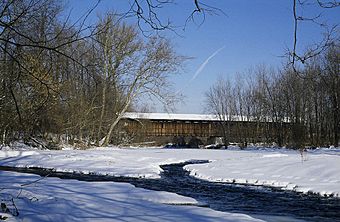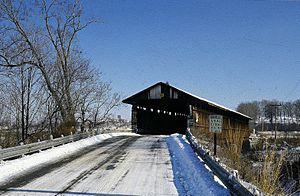Lockington Covered Bridge facts for kids
Quick facts for kids |
|
|
Lockington Covered Bridge
|
|

Southern side of the bridge
|
|
| Nearest city | Lockington, Ohio |
|---|---|
| Area | less than one acre |
| Built | 1848 |
| Architectural style | Long truss |
| NRHP reference No. | 75001532 |
| Added to NRHP | June 10, 1975 |
The Lockington Covered Bridge was a special old bridge in Ohio, United States. It was built in 1848 and crossed the Great Miami River near Lockington. This bridge was a "covered bridge," meaning it had a roof and sides, like a long tunnel.
It was made mostly of wood, with a wooden roof and strong stone supports called abutments at each end. The bridge was about 170 feet (52 meters) long and had two main sections. It cost $1,500 to build, which was a lot of money back then!
Building a Strong Bridge
The Lockington Covered Bridge used a special building method called the Long Truss design. This was a clever way to make bridges very strong using wooden beams. It helped the bridge hold up for many years.
When the bridge was built, the area around Lockington was busy. Boats traveled on the Miami and Erie Canal, which helped the local economy. Even after the canal closed, the covered bridge stayed important. It was a reminder of the area's history.
A Special Place in History
By the 1970s, the Lockington Covered Bridge was one of the oldest bridges in its county. It was the only covered bridge still standing in its original spot. It was also one of only eight Long Truss covered bridges left in all of Ohio.
Because it was so important for engineering and history, the bridge was added to the National Register of Historic Places in 1975. This list recognizes places that are important to the history of the United States.
What Happened to the Bridge?
Sadly, the Lockington Covered Bridge started to wear out over time. By 1985, its stone supports were damaged. The wooden floor also began to rot. Because of these problems, the county decided to close the bridge to keep people safe.
Four years later, in 1989, something unexpected happened. The bridge was destroyed by a fire. Before the fire, there were plans to create a park around the bridge. These plans had to be canceled after the bridge was gone. Even though the bridge was destroyed many years ago, it is still listed on the National Register of Historic Places.




